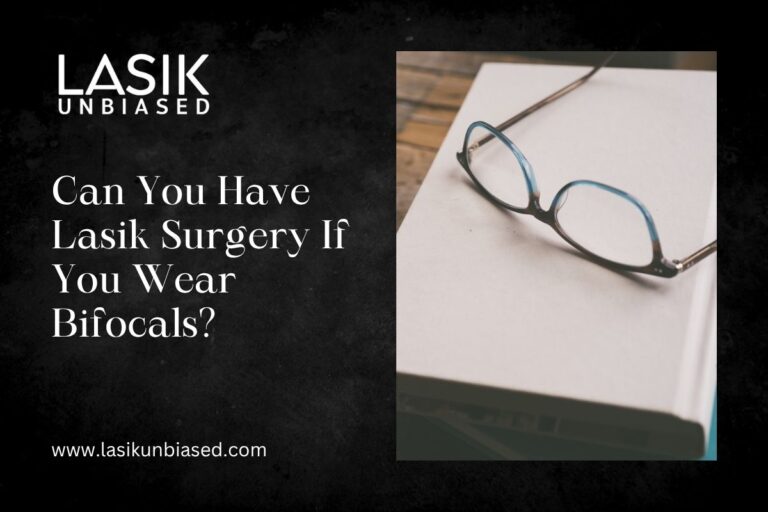Yes, you can have LASIK surgery if you wear bifocals, but the procedure and expectations are different from standard LASIK.
Most bifocal wearers benefit from specialised techniques like monovision LASIK or multifocal LASIK, which aim to reduce or eliminate your dependence on bifocals by addressing both near and distance vision in unique ways.
If you rely on bifocals to see both far and near, you might wonder if LASIK can offer you the same freedom from glasses that it does for others. This blog explains how LASIK works for bifocal wearers, what options are available, and what you can realistically expect after surgery.
Understanding Bifocals and Why People Need Them?
Bifocals are glasses with two distinct lens powers: one for distance and one for near vision. Most people start needing bifocals as they age due to a condition called presbyopia, where the eye’s natural lens loses flexibility and can’t focus on close objects as easily. This is a normal part of ageing, often starting in your 40s or 50s.
Key points about bifocals:
- They correct both distance and near vision in a single pair of glasses.
- Presbyopia is the most common reason for needing bifocals.
- Bifocals are not just for seniors; anyone with both distance and near vision issues may use them.
How LASIK Works and Its Limits for Bifocal Wearers?
Conventional LASIK corrects nearsightedness, farsightedness, and astigmatism by reshaping the cornea. However, it does not restore the flexibility of the eye’s natural lens, so it can’t “cure” presbyopia.
What does this mean for bifocal wearers?
- Standard LASIK can correct distance vision, but you may still need reading glasses for near tasks.
- If you only have presbyopia (age-related near vision loss), traditional LASIK alone won’t eliminate your need for bifocals.
Monovision LASIK: The Most Common Solution for Bifocal Users
Monovision LASIK is the most popular LASIK approach for people who wear bifocals. In this procedure, your dominant eye is corrected for distance vision, while your non-dominant eye is set for near vision. Your brain learns to blend the two, so you can see at most distances without glasses.
How Monovision LASIK Works?
- The surgeon corrects one eye to see clearly at a distance, while the other is adjusted to enhance near vision.
- Your brain adapts to use each eye for its intended purpose.
- Most people can read, use a computer, and drive without glasses after adapting to monovision.
Who Is a Good Candidate?
- People over 40 who use bifocals or reading glasses.
- Those willing to try monovision with contact lenses before surgery (a common test to ensure you can adapt).
- Patients with healthy eyes and stable prescriptions.
Pros and Cons of Monovision LASIK
| Pros | Cons |
| Reduces or eliminates need for bifocals | Some people struggle to adapt to monovision |
| Good for most daily activities | May affect depth perception and night vision for some users |
| Quick recovery and long-lasting results | Not ideal for high-performance sports or certain professions |
Multifocal and PresbyLASIK: Advanced Options for Bifocal Wearers
Some clinics offer multifocal LASIK (PresbyLASIK), which reshapes the cornea to create multiple zones for near, intermediate, and distance vision—similar to multifocal contact lenses or progressive glasses. This approach is newer and not as widely available as monovision.
How Multifocal LASIK Works?
- The cornea is sculpted into zones, each focusing at a different distance.
- Your brain selects the right zone for the task, providing a range of clear vision.
Effectiveness and Considerations
- Studies show good results for both near and distance vision, with many patients achieving independence from glasses for most tasks.
- Some people may notice reduced contrast sensitivity or mild visual disturbances, such as halos or glare, especially in low light.
- Not everyone is a candidate; a thorough evaluation is needed.
What to Expect After LASIK If You Wear Bifocals?
Will you still need reading glasses after LASIK?
- Many patients no longer need bifocals after monovision or multifocal LASIK.
- Over time, as your natural lens continues to age, you might need reading glasses again, especially for fine print or prolonged reading.
Is LASIK permanent for bifocal users?
- The corneal changes from LASIK are permanent, but presbyopia will continue to progress as you age.
- Some people may need enhancement procedures or additional treatments later.
Are there risks or side effects?
- As with any surgery, risks include dry eyes, glare, halos, or reduced night vision.
- Most side effects are temporary, but a small percentage of people may experience ongoing issues.
Alternatives to LASIK for Bifocal Wearers
If LASIK isn’t right for you, several alternatives exist:
- Refractive Lens Exchange (RLE): Your eye’s natural lens is replaced with an artificial multifocal lens, addressing both distance and near vision.
- PRK, SMILE, or LASEK: Other laser procedures may be suitable depending on your eye health and prescription.
- Contact lenses: Multifocal or monovision contacts are non-surgical options.
- Reading glasses or bifocals: Still a reliable, non-invasive choice for many.
Key Questions to Ask Before LASIK If You Wear Bifocals
- Am I a candidate for monovision or multifocal LASIK?
- What are the risks and benefits for my specific eyes and lifestyle?
- Should I test monovision with contact lenses before proceeding?
- What should I expect for near and distance vision after surgery?
- Are there non-surgical alternatives that might suit me better?
How to Decide If LASIK Is Right for You?
A comprehensive eye exam and consultation with a LASIK specialist are crucial. Your doctor will evaluate your eye health, the stability of your prescription, and your lifestyle requirements before suggesting the best option for you.
Many clinics offer a “test drive” of monovision with contact lenses to ensure you’re comfortable with the adjustment.
LASIK and Bifocals—A Personalised Solution
You can have LASIK surgery if you wear bifocals, but the procedure is tailored to address both your distance and near vision needs, usually through monovision or multifocal techniques. While LASIK can reduce or even eliminate your need for bifocals, it’s not a one-size-fits-all solution. The best results come from a personalised approach, guided by an experienced eye surgeon who understands your goals and lifestyle.
Ready to explore your options? Schedule a comprehensive LASIK consultation to find out if monovision or multifocal LASIK can help you say goodbye to bifocals—and hello to clearer, more convenient vision.


